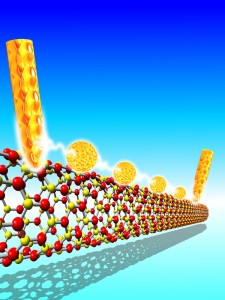
Since it was published online in Advanced Materials, the article “Room-Temperature Tunneling Behavior of Boron Nitride Nanotubes Functionalized with Gold Quantum Dots,” coauthored by physics professor Yoke Khin Yap, has received exceptional attention. The related new release, “Beyond Silicon: Transistors without Semiconductors,” appeared in numerous websites and blogs. The Altmetric system, which measures the social impact of a scholarly literature, gave it a score of 86.
The article has scored higher than all articles from Advanced Materials published within six weeks on either side of its publication date. Articles from this journal typically receive more attention than average, with a mean Altmetric score of 7.1 compared to the global average of 3.8. This article’s score places in the 99th percentile of the 1.4 million articles across all journals tracked by Altmetric.
Yap’s article also highlighted in a number of professional societies, including IEEE Spectrum of the Institute of Electrical and Electronics Engineers , Ceramic Tech Today from the American Ceramic Society, and the Center for Nanophase Materials Sciences in Oak Ridge National Laboratory.
The researchers’ work is described in the article “Room Temperature Tunneling Behavior of Boron Nitride Nanotubes Functionalized with Gold Quantum Dots,” and published in issue 33/2013, pages 4544-4548 of Advanced Materials. In addition to Yap, coauthors include Professor John Jaszczak, research scientist Dongyan Zhang, postdoctoral researchers Chee Huei Lee and Jiesheng Wang, and graduate students Madhusudan A. Savaikar, Boyi Hao and Douglas Banyai of Michigan Tech; Shengyong Qin, Kendal W. Clark and An-Ping Li of the Center for Nanophase Materials Sciences at ORNL; and Juan-Carlos Idrobo of the Materials Science and Technology Division of ORNL. The work was funded by the Office of Basic Energy Sciences of the US Department of Energy (Award # DE-FG02-06ER46294, PI:Y.K.Yap) and was conducted in part at ORNL (Projects CNMS2009-213 and CNMS2012-083, PI: Y.K.Yap).








